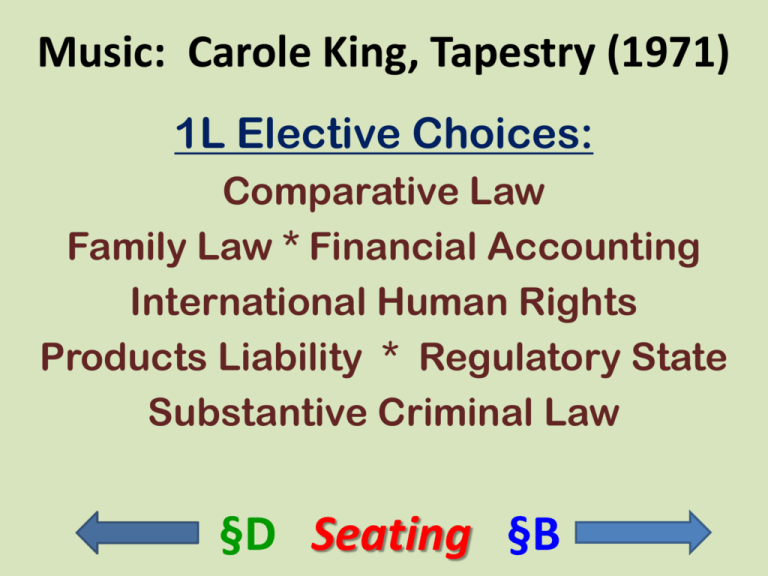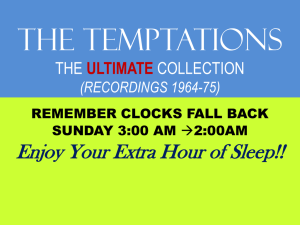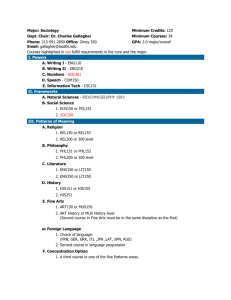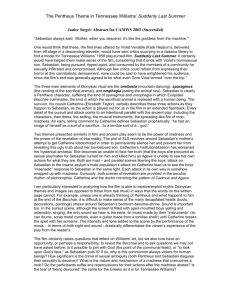Hadacheck v. Sebastian
advertisement

Music: Carole King, Tapestry (1971) 1L Elective Choices: Comparative Law Family Law * Financial Accounting International Human Rights Products Liability * Regulatory State Substantive Criminal Law §D Seating §B Elements B/D: 11/7 featuring the voice talents of Bryston Stafford As Black Friday Approaches: Too Much Every kiss begins with Kay® I’ve seen those Kay Jewelers ads … … but frankly, if I give someone a $5000 diamond bracelet, … … I’m looking for a little more than a kiss. That’s why I shop at … Eff Jewelers Taking Care of Your Family Jewels CHOOSING YOUR 1L ELECTIVE Section B Spring 2015 MON TUE CONTRACTS CRIM PRO DAWSON FRANKS 9:00-10:50 9:30-10:50 CON LAW I WAGNER 2:00-3:20 CON LAW I WAGNER 2:00-3:20 WED THU FRI CONTRACTS CRIM PRO DAWSON FRANKS 9:00-10:50 9:30-10:50 L.COMM II 8:30-10:20 ELECTIVE 11:00-12:20 ELECTIVE 11:00-12:20 CON LAW I WAGNER 2:00-3:20 Section D Spring 2015 MON TUE CONTRACTS CRIM PRO WIDEN SUNDBY 9:00-10:50 9:30-10:50 WED THU CONTRACTS CRIM PRO WIDEN SUNDBY 9:00-10:50 9:30-10:50 ELECTIVE 11:00-12:20 L COMM II 2:00-3:50 (Some) CON LAW I IGLESIAS 3:30-5:20 FRI L COMM II 2:00-3:50 (Some) ELECTIVE 11:00-12:20 CON LAW I IGLESIAS 3:30-5:20 CHOOSING YOUR 1L ELECTIVE The most important decision you will make… CHOOSING YOUR 1L ELECTIVE The most important decision you will make next Monday or Tuesday. CHOOSING YOUR 1L ELECTIVE The most important decision you will make next Monday or Tuesday. Maybe. CHOOSING YOUR 1L ELECTIVE You are picking one course out of the 20 or so electives you will take in law school. CHOOSING YOUR 1L ELECTIVE You are not picking a spouse. CHOOSING YOUR 1L ELECTIVE CHOOSING YOUR 1L ELECTIVE: LOGISTICS • • • • • Read Descriptions Carefully Learn Registration Procedures Check Registration Time (Significance) Checking Availability in Advance Wait Lists & Add/Drop CHOOSING YOUR 1L ELECTIVE: SOME CONSIDERATIONS • • • • Available to Take Later? Method of Evaluation Prerequisite/Intro to Other Courses Furthering Skills & Career Goals CHOOSING YOUR 1L ELECTIVE: SOME CONSIDERATIONS • Past Student Evaluations (@ Circulation Desk for Spring 2012-Spring 2014) • ALL except Products Liability & Regulatory State • Upper Level Students in Room? – Comparative – Int’l Human Rights (Very Limited Number) COMPARATIVE LAW (K.ROSENN) Compare Legal Systems (Civil/Common Law) • • • • Offered Every Year as Upper Level Method of Evaluation: Final Exam Helpful Intro to Comparative/Int’l Courses Good course for int’l careers and for gen’l understanding of law, especially Civil Law FAMILY LAW (B. PERLMUTTER) Legal Relationships between Spouses/Life Partners and between Parents & Children • Offered Every Semester for Upper Level • Method of Evaluation: Class Participation; Final Exam; Negotiation Exercise; and Reflection Papers. • Intro/Prereq. to Upper Level Family Law Electives • Significant # of Students Practice Family Law; Also Useful for Personal Representation & Gen’l Practice FINANCIAL ACCOUNTING FOR LAWYERS (G. MUNDSTOCK) • • • • Intro to Accounting (Legal Perspective) Sometimes Offered to Upper Level Students Method of Evaluation: Final Exam Helpful Intro to Business Law for Students w/o Business Background Can’t Take as 1L if More Than One Prior Accounting or Finance Course INT’L HUMAN RIGHTS (J. NICKEL) Int’l Law of (& Nature of) Human Rights • Offered Every Year for Upper Level • Method of Evaluation: Class Participation and Final Exam • Intro to Public International Law • Useful skills working with treaties & int’l law; relevant to gov’t int’l practice, immigration, and US civil rights. • Check Prof’s Website for Additional Info PRODUCTS LIABILITY (Z. FENTON) Advanced Torts Class • New Course: No Guarantee that Will be Offered as Upper Level • Method of Evaluation: Final Exam • Not direct pre-requisite or intro for other courses; techniques & skills may be relevant in advanced business and litigation courses. • Significant part of personal injury and insurance practice and often part of general business litigation practice. REGULATORY STATE (C. COPELAND) Federal Legislative & Administrative Process • To Date, Only Offered as 1L Elective • Method of Evaluation: Final Exam & One Other Graded Assignment • Very Helpful for Lots of Upper Level Courses; Good Synergy with US Con Law I • Central to Many Areas of Law (E.g., Civil Rights, Communications, Consumer, Environmental, Health Care, Immigration, Labor, Tax) SUBSTANTIVE CRIMINAL LAW (MAHONEY) Elements of Crimes & Defenses • Offered Every Semester for Upper Level • Method of Evaluation: Final Exam & Short Exercises • Intro/Prereq. to Upper Level Crim Electives; Good Synergy with Crim. Pro. • Many Students Practice Criminal Law; Comes Up in Every Area of Practice, Personal Representation and Family Conversations. CHOOSING YOUR 1L ELECTIVE: QUESTIONS? REVIEW PROBLEM 2J 2012 XQ2 (Escape): Discuss whether the Escaping Animals Cases are good tools to resolve disputes about rights to control commercial use of human gestures strongly identified with particular individuals. 1. Arguments from Factual Similarities & Differences (KRYPTON) 2. Arguments re Usefulness of Legal Rules/Factors (URANIUM) 3. Arguments re Comparisons to Alternatives (RADIUM) FINAL EXAM QUESTIONS 1 & 2 XQ1: “Assuming Animals Cases Apply, Discuss Who Should Get Property Rights?” • Traditional Issue-Spotter, But Need to Be Creative Applying Doctrine • Focus of Discussion: Who Should Win Here? – Applying Doctrine from ACs – Looking Only at Specific Parties in Fact Pattern FINAL EXAM QUESTIONS 1 & 2 XQ2: “Discuss Whether ACs Are Good Tools to Use in This Type of Scenario” • Having Tried ACs in the Specific Circumstances of the Fact Pattern, Take a Step Back • Can Think About as Addressing Legislature or State Supreme Court : How Should the State Handle Situations Like the Fact Pattern? • No longer “Referee” applying rules to players in game, but “Consultant” presenting report to “Rules Committee” about what rules should be. FINAL EXAM QUESTIONS 1 & 2 XQ2: “Discuss Whether ACs Are Good Tools to Use in This Type of Scenario” • Can Think About as Addressing Legislature or State Supreme Court : How Should the State Handle Situations Like the Fact Pattern? • In What Ways Are the ACs Useful Tools? In What Ways Are They Not Useful? • In What Ways Are ACs Better or Worse Than Plausible Alternatives? FINAL EXAM QUESTIONS 1 & 2 XQ2: “Discuss Whether ACs Are Good Tools to Use in This Type of Scenario” • OK to Refer to Facts of Problem as Examples of Situations or Problems that Might Arise, but Application of Specific Doctrine to Specific Facts Belongs in Q1. • Cf. Notorious/Unpopular Application of Rule in Sporting Event • Once event is finished, can’t “relitigate” the specific result • BUT Can have a conversation about whether and how to change the rules. REV. PROB. 2J: 2012 XQ2 Discuss whether the Escaping ACs are good tools to resolve disputes about rights to control commercial use of human gestures strongly identified with particular individuals (SIPI). Assume we only would give property rts to gestures that are: • Not commonly used in everyday life • Very strongly associated with a particular public figure I’m Just Working with People I Call on from Panel REV. PROB. 2J: 2012 XQ2 Krypton-B: Factual Similarities Discuss whether the Escaping ACs are good tools to resolve disputes about rights to control commercial use of human gestures strongly identified with particular individuals. • Identify a Factual Similarity between i. ii. Situations/Disputes Involving Escaping Wild Animals; Situations/Disputes Involving the Use of Human Gestures SIPI • Explain why the Similarity suggests that the Escaping ACs would be good tools for resolving the latter situations. REV. PROB. 2J: 2012 XQ2 Krypton-D: Factual Differences Discuss whether the Escaping ACs are good tools to resolve disputes about rights to control commercial use of human gestures strongly identified with particular individuals. • Identify a Factual Difference between i. ii. Situations/Disputes Involving Escaping Wild Animals; Situations/Disputes Involving the Use of Human Gestures SIPI • Explain why the Difference suggests that the Escaping ACs might not be useful for resolving the latter situations. REV. PROB. 2J: 2012 XQ2 Uranium-D: Useful Factors Discuss whether the Escaping ACs are good tools to resolve disputes about rights to control commercial use of human gestures strongly identified with particular individuals. • What Rules/Factors from the Escaping ACs Would Be Useful for Disputes re the Use of Human Gestures SIPI (and Why)? REV. PROB. 2J: 2012 XQ2 Uranium-B: Less Useful Factors Discuss whether the Escaping ACs are good tools to resolve disputes about rights to control commercial use of human gestures strongly identified with particular individuals. • What Rules/Factors from the Escaping ACs Would Be Less Useful (Hard to Use or Not Very Relevant) for Disputes re the Use of Human Gestures SIPI (and Why)? REV. PROB. 2J: 2012 XQ2 Radium: Alternatives Discuss whether the Escaping ACs are good tools to resolve disputes about rights to control commercial use of human gestures strongly identified with particular individuals. • Possible Alternative Approaches? • Some Pros & Cons • I’ll Take Qs After Class or by E-Mail FINAL EXAM QUESTION 3 OPINION/DISSENT FORMAT (1998) • Draft the analysis sections of an opinion for the Supreme Court and of a shorter dissent deciding whether there has been an unconstitutional taking of Bart’s property. – Assume that the record supports the trial court’s findings of fact. – Assume that the Supreme Court cases decided prior to 1980 constitute the available precedent. – The opinions you draft also may discuss the Takings theorists to the extent you find their work relevant. FINAL EXAM QUESTION 3 OPINION/DISSENT FORMAT • Requires You to Describe and Defend Two Positions FINAL EXAM QUESTION 3 OPINION/DISSENT FORMAT • Requires You to Describe and Defend Two Positions • Must Show that You Understand Range of Relevant Arguments Arising from Line of Takings Cases Skills: Applying Legal Authority to New Sets of Facts 1. Applying Language (Rules, Factors, Elements) 2. Comparing Facts 3. Applying Relevant Policies Skills: Applying Legal Authority (Line of Takings Cases) to New Sets of Facts 1. Applying Language (Rules, Factors, Elements) – Must be Consistent with Whole Line, Not Just Individual Case – Need to Adjust Your Notes/Outline After Each New Case 2. Comparing Facts: 3. Applying Relevant Policies Skills: Applying Legal Authority (Line of Takings Cases) to New Sets of Facts 1. Applying Language (Rules, Factors, Elements) 2. Comparing Facts: – Often Useful to Compare to Two Cases with Different Results – More Like Hadacheck Than Like Mahon Because … 3. Applying Relevant Policies Skills: Applying Legal Authority (Line of Takings Cases) to New Sets of Facts 1. Applying Language (Rules, Factors, Elements) 2. Comparing Facts: 3. Applying Relevant Policies – Remember NOT looking at policy used by legislature to create challenged law – Relevant policy addresses what kinds of gov’t interference with property rights require compensation FINAL EXAM QUESTION 3 OPINION/DISSENT FORMAT • Requires You to Describe and Defend Two Positions • Must Show that You Understand Range of Relevant Arguments Arising from Line of Cases • Must Understand Role of US Supreme Court (Useful for Justice or Clerk or Litigant) – Deciding One Case, BUT Setting Rules for Many – Can Choose to Affirm or Modify Precedent BUT Must Defend – Need to Resolve One or More Difficult Open Qs (We’ll Identify As We Go) FINAL EXAM QUESTION 3 OPINION/DISSENT FORMAT • Look at Posted Examples • We’ll Discuss at More Length & Do Review Problems Identifying and Targeting Difficult Open Legal Qs Unit Three : Introduction Relevant Considerations in Takings Cases Survey of Instincts About What Facts Matter (2014: 13/94 said all 6 matter) • • • • • • Ban on Intended Use % Reduction in Value Purpose of Regulation $$$ Amount Reduction $$$ Amount Left Return on Investment 2014 90% 88% 63% 59% 56% 39% 2012 90% 90% 54% 62% 43% 26% Unit Three : Introduction Relevant Considerations in Takings Cases Survey Data on Instincts A B Current Use Unlimited Eliminated % Value Lost 60% 5% Value Lost N/A N/A Orig. Just Now N/A Purchase Avg. Rank (1 = Strongest) 3.0/3.0 2.6/2.8 2014/2012 C D E Limited 80% $80K N/A Limited Unlimited 10% 60% $1M $120K N/A 5 Yrs @ 50K/ 200K 80K 1.7/1.8 3.6/3.5 4.0/3.8 Hadacheck v. Sebastian (1915) OXYGEN: DQs 3.06-3.09 Hadacheck v. Sebastian Background: Growth of Los Angeles • OIL: Discovered 1876; SoCal produces 25% of world’s oil in 1920s • WATER: Aqueduct Completed in 1913 • MOVIE INDUSTRY: Beginning 1910 – Weather/Sunlight – Proximity to Mexico & Patent Evasion • POPULATION (~50,000 in 1890) – – – – 1900 = 1910 = 1920 = 1930 = ~ 102,000 ~ 319,000 ~ 577,000 ~1,238,000 Hadacheck v. Sebastian DQ3.06: Introduction (Oxygen) • Useful in Takings cases to begin analysis with the challenged gov’t action, rather than with a description of the lawsuit. • DQ3.06 provides a standard set of Qs that we will use for all four primary Takings Cases to help you understand what’s at issue. Hadacheck v. Sebastian DQ3.06: Introduction (Oxygen-B) Challenged Action & Rational Basis Review • Government action in Hadacheck: (p.106) L.A. Ordinance banning operation of brickyard in city • What is the purpose of the action? • Legitimate (HSWM)? • Is the action rationally related to the purpose? Hadacheck v. Sebastian DQ3.06: Introduction (Oxygen-D) Effects of the Challenged Action • Government action in Hadacheck: (p.106) L.A. Ordinance banning operation of brickyard in city • What limits are placed on the petitioner’s use of his property? • What uses of his property are still permissible? • What is the harm to the petitioner? Hadacheck v. Sebastian DQ3.06: Introduction (Oxygen) Effects of the Challenged Action • What is the harm to the petitioner? • Incarceration! • Claims re Value in Habeas Petition: • Property worth $800,000 as brickworks • Worth $60,000 as anything else • NOTE: Cal & US Supreme Courts don’t necessarily accept these claims Hadacheck v. Sebastian DQ3.06: Introduction (Oxygen) • (1915) Claim re Property Value (PV): • Property worth $800,000 as brickworks • Worth $60,000 as anything else • Claims re Loss of PV Often Short Term • PV Fluctuates Significantly Over Time • This was new part of LA; must have increased sharply at some point Brickworks Site 11/2012: West Pico & Crenshaw Blvds., Los Angeles, CA Hadacheck v. Sebastian DQ3.06: Introduction (Oxygen-B) Fit Into Demsetz Takings Story? • Activity is Brickmaking • Externalities: Some dust reaches nearby residents • Old Rule: Brickworks Allowed to Operate if There First • Change? • Leads to rising externalities? • Change in the law? Hadacheck v. Sebastian DQ3.06: Introduction Fit Into Demsetz Takings Story? • Activity is Brickmaking • Growth of LA Increases Externalities • Change in the law = New zoning ordinance banning brickworks • After the change, people affected by the new law complain that their property rights have been “taken.” (= Hadacheck Litigation) Hadacheck v. Sebastian Procedural Posture • Hadacheck convicted for violating ordinance • Files Habeas Petition w California SCt; Loses • Appeal to US SCt – Claim that state law violated US Constitution – At time, automatic appeal rather than petition for certiorari Hadacheck v. Sebastian Procedural Posture • Hadacheck convicted for violating ordinance • Files Habeas Petition w California SCt; Loses • Appeal to US SCt • Status of Allegations in Petition (pp.107-08) – p.108: “substantial traverses” in reply by Chief of Police – Cal SCt found against Petitioner on facts re health, discrimination, etc. – US SCt says these findings supported by evidence Hadacheck v. Sebastian: Reasoning DQ3.07 Discrimination Claim • Petitioner Says: – I was singled out; ordinance passed to stop me – Other brickworks in other districts treated differently • How did the court deal with this claim? – Cal SCt found ordinance not arbitrary/discriminatory – US SCt said sufficient evidence supports that finding Hadacheck v. Sebastian: Reasoning DQ3.07 Arbitrariness/Discrimination Claims • Made Frequently (Hadacheck, Miller, Penn Central) • Hard to Win – Must Be: • Explicit Direct Attack on Someone -OR• Very Random Exercise of Govt Power – Rare Example: Eubank (cited in Miller) complete delegation of zoning decision to neighbors with no gov’t oversight Hadacheck v. Sebastian: Reasoning DQ3.07 Arbitrariness/Discrimination Claims • Made Frequently But Hard to Win • Generally OK to draw rough but plausible distinctions – E.g., Between people under/over 21 years old – E.g., Between neighborhoods – E.g., Between types or size of brickworks, etc. – Unless courts have found distinction problematic under Equal Protection Clause or First Amdt (race; religion, etc.) Hadacheck v. Sebastian: Reasoning DQ3.07 Arbitrariness/Discrimination Claims • Made Frequently But Hard to Win • Generally OK to draw rough but plausible distinctions • I won’t (intentionally) make arbitrariness a serious issue on final; don’t spend time on it!! Hadacheck v. Sebastian: Reasoning DQ3.08 (Police Power) Brief Aside on Nuisance Law • Tort to Protect Property Rights: Your use of your own land is interfering with my use of my land (e.g., noise, smoke, odors) • Exposure in Torts or Property? • Private Nuisance: Lawsuits by private individuals. – Defenses: First in Time & Oversensitiveness • Public Nuisance: – Statutes banning particular harmful land uses – Lawsuits for widespread harms to other people’s use of land (no first in time defense) Hadacheck v. Sebastian: Reasoning DQ3.08 (Oxygen-D) Hadacheck & the Police Power (p.109) • “[O]ne of most essential powers of government—one that is the least limitable.” (p.109) • “A vested interest cannot be asserted against it because of conditions once obtaining.” – MEANS? Hadacheck v. Sebastian: Reasoning DQ3.08 (Oxygen-d) Hadacheck & the Police Power (p.109) • “A vested interest cannot be asserted against it because of conditions once obtaining.” • Compare “Coming to the Nuisance” – First-in-Time Defense for Private Nuisance – Not defense for Public Nuisance Hadacheck v. Sebastian: Reasoning DQ3.08 (Oxygen-D) Hadacheck & the Police Power: Reinman • Little Rock bans livery stables – Related to Change from Horses to Cars – Similar Facts Alleged re Loss of Property Value – US SCt says OK under Police Power • Why does Petitioner in Hadacheck say L.A. Ordinance Distinguishable? Hadacheck v. Sebastian: Reasoning DQ3.08 (Oxygen-D) Hadacheck & the Police Power: Reinman • Little Rock bans livery stables; US Sct says OK • Petitioner: L.A. Ordinance Distinguishable b/c Brickworks Tied to Particular Location (Clay Pits) • But Court Responds: Not Impossible to Run Business Elsewhere • Reliance on Reinman suggests that under Police Power, OK to severely reduce value by eliminating current use. Hadacheck v. Sebastian: Reasoning DQ3.08 (Oxygen-D) Hadacheck & the Police Power: Kelso • San Francisco banned operation of rock quarry • Cal. S.Ct. said unconstitutional • Why Distinguishable from Hadacheck ? Hadacheck v. Sebastian: Reasoning DQ3.08 (Oxygen-D) Hadacheck & the Police Power: Kelso • San Francisco banned operation of rock quarry • Cal. S.Ct. said unconstitutional; distinguishes Hadacheck because: – In Kelso, if you can’t quarry, rock is valueless – In Hadacheck, clay still has value; can remove & process elsewhere Hadacheck v. Sebastian: Reasoning DQ3.08 (Oxygen-D) Hadacheck & the Police Power: Kelso • Cal. S.Ct. draws distinction between – Limit on use of land; and – Complete elimination of value • US SCt not bound by California state decision. Does US SCt adopt Kelso reasoning? Hadacheck v. Sebastian: Reasoning DQ3.08 (Oxygen-D) Hadacheck & the Police Power: Kelso • Cal. S.Ct. draws distinction between limit on use of land and complete elimination of value • US SCt not bound by California state decision. Does US SCt adopt Kelso reasoning? – Explicitly reserves Q in last paragraph of opinion – Does note clay still is available & has value Hadacheck v. Sebastian: Reasoning DQ3.08 (Oxygen-D) Hadacheck & the Police Power: Kelso • Cal. S.Ct. draws distinction between limit on use of land and complete elimination of value • Distinction raises important recurring Q: In deciding if value remains, do you look at: – All property owned by claimant (quarry + rock) – Particular property most directly effected (just rock) – Still value left in quarry, but not in rock. Hadacheck v. Sebastian: Reasoning DQ3.08 (Oxygen-D) Hadacheck & the Police Power: Kelso • Important recurring Q: In deciding if value remains (or amount of value lost), what portion of claimant’s property do you look at? • We’ll call this the “denominator” question: – What do you use as denominator in fraction showing how much property is lost (or is left)?








